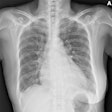In the quest for an optimum balance between image quality and radiation dose in digital radiography (DR), a U.K. group looked at whether better DR image quality provided through the use of an antiscatter grid justified an increase in effective dose to patients.
That conclusion is among the findings from a study based on the review of 54 lateral cervical spine and 46 anterior-posterior (AP) shoulder exams taken over the course of two months at Neath Port Talbot Hospital in South Wales, U.K., using a digital radiography system. Approximately half of the images were taken without the use of an antiscatter grid to compare image quality.
Details of the study were published in the September issue of the Journal of Radiological Protection (September 2006, Vol. 26:3, p. 287-299).
Antiscatter grids traditionally have been used in analog x-ray applications to focus radiation on a specific target and improve image quality, as scattered radiation often leads to reduced contrast and poor patient images. Today's antiscatter grids can reduce scatter by as much as 90%.
Setting criteria
The U.K. study analyzed images acquired from a DR system incorporating an x-ray tube suspended from the ceiling and a cesium iodide-based flat-panel detector with an amorphous silicon photodiode/TFT (thin-film transistor) array configured in a vertical stand (Revolution XR/d2, GE Healthcare, Chalfont St. Giles, U.K). All 100 patients were imaged with the upright bucky and the antiscatter grid. Radiographers also alternated use of the grid for each examination.
Two radiologists -- a vascular and thoracic specialist with 11 years of experience and a radiologist with a 12-year background in musculoskeletal images -- rated the images independently, using the DIMOND III European digital image quality guidelines for AP shoulder and lateral cervical spine examinations.
The DIMOND III group, which includes 13 medical specialists with varied backgrounds from 11 European countries, is working to develop new techniques to make interventional radiology, digital imaging, and mammography safer for patients. DIMOND III's primary focus is on improving image quality without increasing radiation dose to patients, optimizing the image quality-to-dose ratio, and developing radiological image quality criteria.
Antiscatter proficiency
What the study found from the radiologists' evaluations is that "the increase in radiation dose to the patient when using the antiscatter grid for AP shoulder examinations is not justified by the improved image" and that because all images were of diagnostic quality, "the use of the antiscatter grid was unnecessary."
The report also noted that use of an antiscatter grid for AP shoulder examinations "results in an increase in effective dose of five and four times that measured without the antiscatter grids for males and females, respectively," adding that it was "possible to determine that there was little significant difference in image quality with or without the grid inserted in terms of fulfilling the DIMOND III image quality criteria."
The bottom line is that the increase in effective dose to the patient was not justified by the improvement in image quality provided by the grid.
"The department was, therefore, advised that the optimal technique for AP shoulder examinations should not involve use of the grid," the study recommended, "with the exception of very large patients where the increase in scattered radiation may appreciably degrade image quality."
The South Wales study follows in line with results of similar research published in the British Journal of Radiology in 2000 (September 2000, Vol. 73:873, pp. 963-968), which reviewed 100 chest radiographs obtained with selenium-based digital radiography, with and without an antiscatter grid.
Researchers found that anatomical landmarks, catheters, and wire cerclages were statistically better visualized in regions of high attenuation when the images were performed with an antiscatter grid. Their conclusion was to not recommend an antiscatter grid for chest radiography, because it "increases the radiation exposure of patients without having a significant impact on visualization for all regions of the chest."
By Wayne Forrest
AuntMinnie.com staff writer
September 22, 2006
Related Reading
Digital radiography slowly, but surely, makes its mark, July 25, 2006
Digital x-ray unreliable for evaluating bone healing, May 31, 2006
Asian digital x-ray market primed for growth, February 17, 2006
PACS drives European CR, DR market, January 10, 2006
Workflow gains drive European PACS market
Copyright © 2006 AuntMinnie.com



















